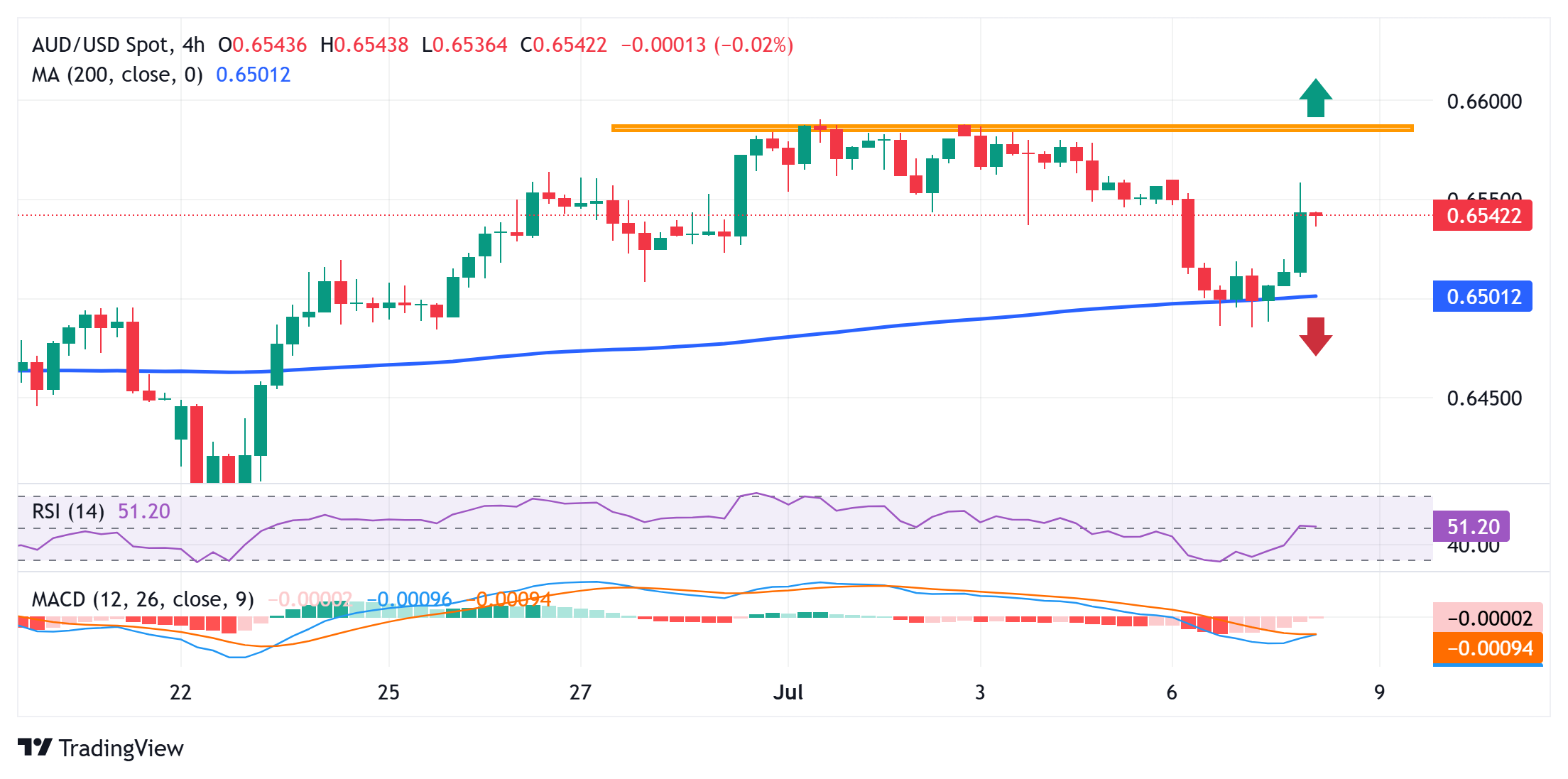
- AUD/USD gains strong positive traction in reaction to the RBA’s surprise on hold decision.
- The emergence of fresh USD selling contributes to the bid tone surrounding the major.
- Trade jitters weigh on investors’ sentiment and might cap the risk-sensitive Aussie.
The AUD/USD pair rebounds sharply from a two-week low touched the previous day following the Reserve Bank of Australia’s (RBA) unexpected decision to keep interest rates unchanged at 3.85%, or the lowest level since May 2023. This came as a surprise to the markets, which had fully priced in the third interest rate cut of the year. In the accompanying policy statement, the central bank noted that the monthly inflation, on the margin, was still slightly stronger than forecast. Adding to this, board members indicated the need for more data to confirm that inflation is trending toward the medium-term target range. Traders were quick to react and tempered their bets for a 25-basis-point rate cut in August, which, in turn, provided a goodish lift to the Australian Dollar (AUD).
The US Dollar (USD), on the other hand, retreats from a one-and-a-half-week high touched on Monday amid concerns about the worsening US fiscal condition. This turns out to be another factor that contributed to the AUD/USD pair’s strong intraday rally of around 65-70 pips. However, the growing acceptance that the Federal Reserve (Fed) will keep interest rates elevated, amid expectations that US President Donald Trump’s tariffs would underpin US inflation in the coming months, acts as a tailwind for the buck. In fact, Trump released letters outlining higher trade tariffs against a slew of Asian and African countries, and also threatened that any country aligning with the anti-American policies of BRICS will be charged an additional 10% tariff. This, in turn, caps the AUD/USD pair.
Traders also seem reluctant and opt to wait for more cues about the Fed’s rate-cut path before placing fresh directional bets in the absence of any relevant market-moving economic data from the US on Tuesday. Hence, the focus will remain glued to the release of FOMC meeting minutes on Wednesday, which will play a key role in influencing the USD price dynamics and providing some meaningful impetus to the AUD/USD pair. In the meantime, the aforementioned mixed fundamental backdrop warrants some caution for bullish traders and positioning for any further appreciating move.
AUD/USD 4-hour chart

Technical Outlook
The AUD/USD pair showed some resilience below the 0.6500 psychological mark and the subsequent move up favors bullish traders amid still positive oscillators. The said handle coincides with the 200-period Simple Moving Average (SMA) on the 4-hour chart and should now act as a key pivotal point, which if broken decisively might prompt some technical selling. Spot prices might then accelerate the fall towards the 0.6465-0.6460 intermediate support en route to the 0.6420-0.6415 region, or the 200-day SMA, and the June monthly swing low, around the 0.6375-0.6370 area.
On the flip side, some follow-through buying could lift the AUD/USD pair to the year-to-date peak touched last week and make a fresh attempt to conquer the 0.6600 round figure. A sustained strength beyond the latter will reaffirm the near-term positive bias and pave the way for a move towards the next relevant hurdle near the 0.6640 hurdle. The upward trajectory could extend further to the 0.6680 intermediate hurdle, or November 2024 swing high, before spot prices aim to reclaim the 0.6700 mark for the first time since October 2024.
Information on these pages contains forward-looking statements that involve risks and uncertainties. Markets and instruments profiled on this page are for informational purposes only and should not in any way come across as a recommendation to buy or sell in these assets. You should do your own thorough research before making any investment decisions. FXStreet does not in any way guarantee that this information is free from mistakes, errors, or material misstatements. It also does not guarantee that this information is of a timely nature. Investing in Open Markets involves a great deal of risk, including the loss of all or a portion of your investment, as well as emotional distress. All risks, losses and costs associated with investing, including total loss of principal, are your responsibility. The views and opinions expressed in this article are those of the authors and do not necessarily reflect the official policy or position of FXStreet nor its advertisers. The author will not be held responsible for information that is found at the end of links posted on this page.
If not otherwise explicitly mentioned in the body of the article, at the time of writing, the author has no position in any stock mentioned in this article and no business relationship with any company mentioned. The author has not received compensation for writing this article, other than from FXStreet.
FXStreet and the author do not provide personalized recommendations. The author makes no representations as to the accuracy, completeness, or suitability of this information. FXStreet and the author will not be liable for any errors, omissions or any losses, injuries or damages arising from this information and its display or use. Errors and omissions excepted.
The author and FXStreet are not registered investment advisors and nothing in this article is intended to be investment advice.








